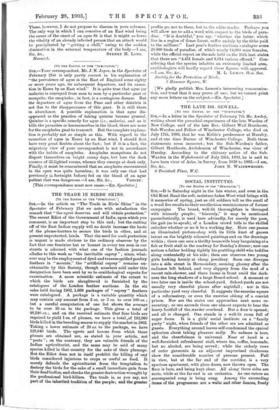[TO THE EDITOR OF THE "SPECTATOR." j Sia,—Your correspondent, Mr.
J. N. Joyce, in the Spectator of February 21st is only partly correct in his explanation of " the prevalence of ague in the East of England some eighty or more years ago, its subsequent departure, and its causa- tion in Essex by an East wind." it is quite true that ague for malaria) is conveyed from man to man by a particular gnat or mosquito, the anopheles ; in fact, is a contagious disease. But the departure of ague from the Fens and other districts is not due to the disappearance of this gnat. It is still there in abundance. A possible explanation is that ague dis- appeared as the practice of taking quinine became general. Quinine is a specific remedy for ague (i.e., malaria), and as it kills the parasites or haemamoebae in the blood, there are none for the anopheles gnat to transmit. But the complete explana- tion is probably not so simple as this. With regard to the causation of ague in Essex by an East wind, I should first have very great doubts about the fact; but if it is a fact, the migratory view of your correspondent is not in accordance with the habits of anopheles. Anopheles mosquitoes do not disport themselves on bright sunny days, but loge the dark corners of ill-lighted rooms, whence they emerge at dusk only. Finally, it must be remembered that an anopheles encountered in the open was quite harmless ; it was only one that had previously (a fortnight before) fed on the blood of an ague










































 Previous page
Previous page